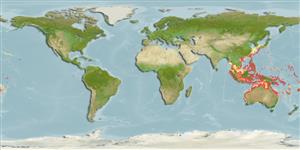Common names from other countries
Environment: milieu / climate zone / depth range / distribution range
Ecologia
marino associati a barriera corallina; distribuzione batimetrica 0 - 70 m (Ref. 86942), usually 0 - 2 m (Ref. 89972). Tropical; 38°N - 33°S, 94°E - 165°W
Pacific Ocean: Philippines to the Society Islands, north to southern Japan, south to Australia (including Rowley Shoals, Western Australia) and Tonga.
Size / Peso / Age
Maturity: Lm ? range ? - ? cm
Max length : 4.5 cm SL maschio/sesso non determinato; (Ref. 48637)
Short description
Chiavi di identificazione | Morfologia | Morfometria
Spine dorsali (totale) : 6 - 7; Raggi dorsali molli (totale) : 10 - 11; Spine anali: 1; Raggi anali molli: 8 - 9. Characterized by dark brown body color and lighter brown to reddish head with five vertical blue lines; young fish with additional vertical lines on body; absence of scales; complete pelvic fin frenum and basal membrane; depth of body at level of pelvic fins 2.6-2.9 in SL (Ref. 90102).
Facultative air-breathing in the genus (Ref. 126274); Found in groups among branches of Acropora coral (Ref. 9710, 48637); a coral-commensal species (Ref. 72446). Feeds on small invertebrates and zooplanktons (Ref. 89972). Monogamous (Ref. 52884). The male takes care of eggs deposited on a coral branch (Ref. 32163). Has the ability to change sex in both directions to favor reproductive success (Ref. 32163).
Life cycle and mating behavior
Maturities | Riproduzione | Spawnings | Egg(s) | Fecundities | Larve
The male takes care of eggs deposited on a coral branch (Ref. 32163). Has the ability to change sex in both directions to favor reproductive success (Ref. 32163). Monogamous mating is observed as both obligate and social (Ref. 52884).
Myers, R.F., 1991. Micronesian reef fishes. Second Ed. Coral Graphics, Barrigada, Guam. 298 p. (Ref. 1602)
IUCN Red List Status (Ref. 130435)
CITES (Ref. 128078)
Not Evaluated
Threat to humans
Harmless
Human uses
Strumenti
Special reports
Download XML
Fonti Internet
Estimates based on models
Preferred temperature (Ref.
115969): 24.9 - 29.3, mean 28.5 (based on 2143 cells).
Phylogenetic diversity index (Ref.
82804): PD
50 = 0.5000 [Uniqueness, from 0.5 = low to 2.0 = high].
Bayesian length-weight: a=0.01995 (0.00906 - 0.04395), b=3.01 (2.83 - 3.19), in cm Total Length, based on all LWR estimates for this body shape (Ref.
93245).
Trophic level (Ref.
69278): 3.4 ±0.5 se; based on size and trophs of closest relatives
Resilienza (Ref.
120179): Alto, tempo minimo di raddoppiamento della popolazione meno di 15 mesi (Preliminary K or Fecundity.).
Fishing Vulnerability (Ref.
59153): Low vulnerability (10 of 100).
